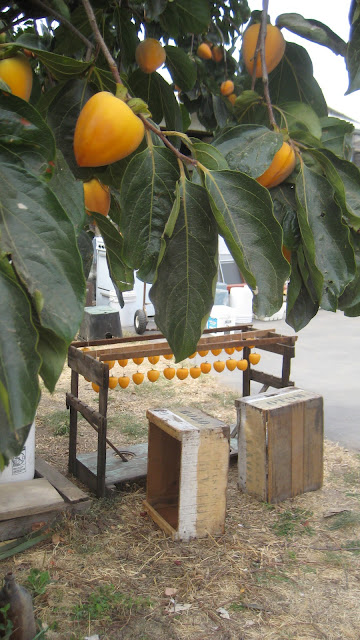 |
| Maru persimmons left in the tree, probably not yet eaten by birds because they're un-pollinated. |
Here are the three types of persimmons:
1. Always sweet when firm--
This includes varieties of fuyu persimmons. People usually eat fuyu type persimmons when they're firm, but you can eat this type of persimmon when it's soft, too if you like it that way. Fuyu are sometimes called "apple persimmon" in stores because you can eat them firm like an apple.
2. Always astringent (puckery) when firm, only sweet when very soft--
This includes hachiya and gyombo varieties. This type is always eaten when it's extremely soft. It needs to be as soft as jello and with translucent skin before its astringency is gone and changed to sweetness. If you eat this type of persimmon when it's not as soft as it should be, it gives your mouth a puckery feeling, sometimes to the point that your mouth feels dried out with a lingering numbness like after having novocain. If you've ever done this, you probably remember. The astringency comes from tannic acid in the unripe persimmon, the same type of acid in green bananas and raw acorns.
3. Pollination dependent (sweet when hard if pollinated, but if not pollinated are sweet only when very soft)--
This type includes maru (chocolate) and hyakume (cinnamon) varieties. If this type of persimmon has been pollinated, it is brown inside and the brown parts are sweet when the persimmon is firm. If it wasn't pollinated, the persimmon will be yellow or orange inside and astringent until it's very soft.
How do you know when you can eat a pollination-dependent type of persimmon? One option is to just wait until it's soft, so you know you can eat it whether or not it was pollinated. Another option is to take a risk and cut one open when it's hard to check if it's been pollinated and is edible then. You might find that it's brown inside and therefore sweet and delicious, or that it has no brown parts and now you've wasted the persimmon.
If you know what to look for, you can see clues from this type of persimmon's shape and color that tell you if it's likely to be pollinated. These clues are more visible on some varieties than others. At the orchard we sell maru persimmons when they're firm because the clues to pollination are easier for some of us to tell, but we always explain to the customers that you never truly know how the persimmon is inside until you cut it open.
Helen, who is over 90 years old and has dealt with persimmons all her life, is great at spotting pollinated marus, but she says that hyakume is more difficult to tell. We treat hyakume persimmons with a little bit of vodka to change any astringency they might have to sweetness. After being treated with vodka, the hyakume is always sweet and edible when it's firm. For more detail about this, see the post "Hyakume & Maru Persimmons".
To make hoshigaki (Japanese hand-dried persimmon), we use the second type of persimmon, the type you eat fresh only when soft. We peel hachiya or gyombo when the persimmon is hard and unripe, but with full color. By the end of the drying process, all the astringency has changed to sweetness and some of its fructose has come to the surface as a powdery natural sugar. Theoretically, you could peel and dry any of the three types of persimmons, but we only use this type. Probably this is because the fuyu type is easy to eat fresh, and because pollination-dependent types of persimmons are more fibery and less sweet when dried. Hachiyas and gyombos are larger, stay more orange and turn out to to be the sweetest and softest type to use to make hoshigaki.

